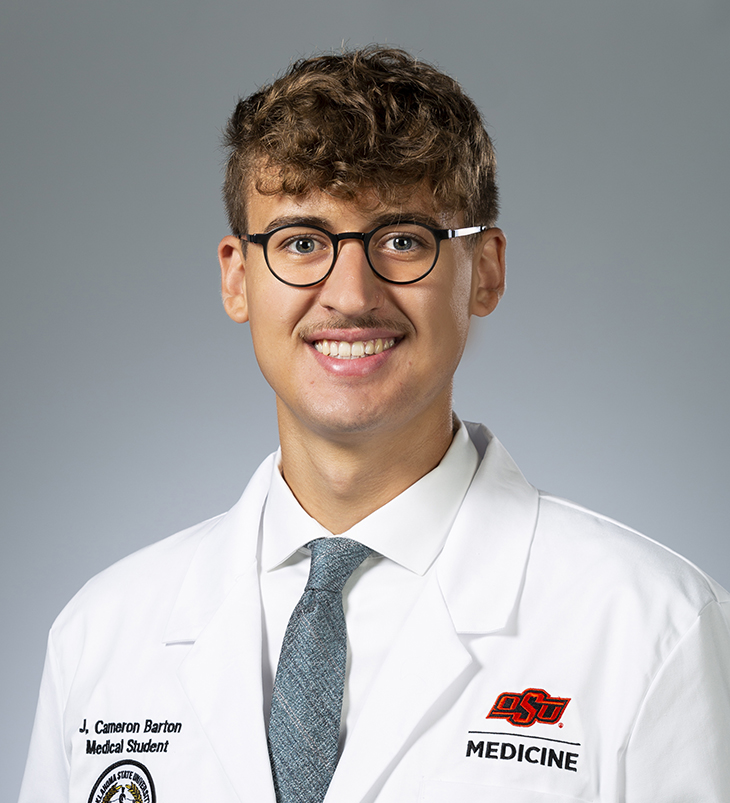
COM student awarded grant to study blood disease
Friday, August 6, 2021
Media Contact: Sara Plummer | Communications Coordinator | 918-561-1282 | sara.plummer@okstate.edu
Oklahoma State University College of Osteopathic Medicine second year student Cameron Barton wants to make diagnosing a dangerous blood disease easier because of two people — his mother and his mentor.
Barton was recognized with the Hemostasis and Thrombosis Research Society (HTRS) Student Research Award to conduct a research project looking at improving a diagnostic test for thrombotic thrombocytopenic purpura (TTP), a blood disease that has a mortality rate of more than 90 percent if left untreated.
“My mother was diagnosed with ITP, which is somewhat similar to TTP, when she was a child, but the diagnostic tools back then were very ineffective and often painful and invasive,” Barton said. “Because of this, I had a personal connection to the project’s goal: developing more efficient, useful tools for diagnosing dangerous blood disorders.”
He also credits his mentor, Dr. Joshua Muia, for even applying for the $8,000 research award. Muia is an assistant professor of Biochemistry and Microbiology at OSU Center for Health Sciences.
“I am extremely grateful for his guidance, and I would not be here if it were not for him. I had zero experience in biochemistry research, but he saw the potential in me and believed my project was strong enough to win the award,” Barton said.
Muia said he knew Barton’s proposal was compelling, but he also knew HTRS research awards are very competitive.
“The award recognizes what kind of work we are doing and the potential impact on the diagnosis of TTP. It was both humbling and exciting,” he said.
Muia’s research focuses on enzymes that prevent the formation of blood clots and the thickening of blood vessels. Patients with TTP have their small blood vessels blocked by blood clots preventing blood with oxygen from circulating through their vital organs.
The goal of Barton’s research project is to validate a new test, also called an assay, for diagnosing TTP. It’s similar to a previous assay developed my Muia and his colleagues, but Barton’s project uses cattle protein instead of human protein for the test — Cattle-VWF71.
“We found that the Cattle-VWF71 assay was around two and a half times as efficient as the previous assay used to diagnose TTP, meaning it requires less resources and less time, but it still an accurate diagnostic tool,” he said. “This assay is also unique in that it can be performed with other species, ranging from mammals to birds to reptiles, which allows for more expansive future research.”
As his research mentor, Muia was responsible for overall oversight and training during the project as well as training Barton on how to deliver scientific presentations, data analysis, scientific literature search and translational research.
“Cameron has made tremendous progress with the project and he has so far performed beyond my expectations. Cameron is hardworking, inquisitive and focused — a recipe for his recent success,” he said. “I would like to encourage D.O. students like Cameron who are interested in research not to be discouraged by a lack of prior research experience. Cameron had similar concerns when he came to see me in my office for the first time. I just told him ‘All you need is passion and to be ready to learn new things.’”
Barton is looking forward to his second year in medical school before taking board exams and beginning rotations next summer. He also plans to continue working with Muia on the next phase of research analyzing why the cattle protein is more efficient.
“I would like to thank the HTRS for their confidence in me and my project and the opportunity they have given me to pursue it. I would also like to thank Dr. Muia who has been an amazing mentor throughout the process and has shown me what a passionate and dedicated researcher looks like,” he said. “I am excited to show HTRS and the rest of the academic community what we can accomplish here at OSU-CHS.”
